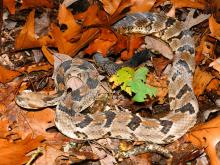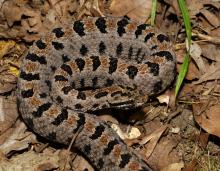Reptiles and Amphibians
Media

Species Types
Scientific Name
Notophthalmus viridescens louisianensis
Description
A small, olive-brown salamander with a fascinating life cycle, the central newt lives in and around woodland ponds and swamps in all but our far northwestern counties.
Media

Species Types
Scientific Name
Hemidactylium scutatum
Description
A glacial relict in Missouri’s eastern Ozarks, the four-toed salamander lives among mosses in heavily forested streams and creeks and sinkhole ponds. It has a thick, round tail that is constricted at its base. There are four toes on each limb.
Media

Species Types
Scientific Name
Plethodon angusticlavius
Description
The Ozark zigzag salamander is small and slender, with a narrow, somewhat lobed back stripe that can be yellow, orange, or red. This woodland species lives in Missouri’s southwestern counties along the Arkansas border.
Media

Species Types
Scientific Name
Eurycea lucifuga
Description
The cave salamander is a common amphibian of the Ozark Plateau. It lives in caves, springs, and rocky streams. Recognize it by its normally bright orange skin dotted with dark brown or black spots.
Media

Species Types
Scientific Name
Ambystoma maculatum
Description
The spotted salamander is one of Missouri's six species of mole salamanders. It is slate black with two irregular rows of rounded yellow spots from the head onto the tail. It occurs in forests in the southern two-thirds of the state.
Media

Species Types
Scientific Name
Pantherophis ramspotti
Description
The western foxsnake is a moderately large snake with distinct brown blotches. In Missouri, it is rare and found only in our far northwestern counties.
Species Types
Scientific Name
Pantherophis vulpinus
Description
The eastern foxsnake is extremely similar to the western foxsnake and is mainly identified by its different geographic distribution: in Missouri, this rare species is found only in a few counties along the Mississippi River floodplain north from St. Louis.
Media

Species Types
Scientific Name
Sonora semiannulata semiannulata
Description
The variable groundsnake is a small species with smooth, shiny scales and highly variable coloration. In Missouri, it is mostly restricted to open, rocky hillsides of the southwestern corner of the state.
Media

Species Types
Scientific Name
Crotalus horridus
Description
Missouri’s largest venomous snake, the timber rattlesnake, is dangerously venomous, but there are few cases of rattlesnake bites in our state. It frequents rough country, is mostly nocturnal in summer, and few Missourians ever encounter it.
Media

Species Types
Scientific Name
Sistrurus miliarius streckeri
Description
The western pygmy rattlesnake is small and colorful, with a slender tail and tiny rattle. Its vibrating rattle is a faint buzz that sounds like a grasshopper. In Missouri, it occurs in the eastern Ozarks and in some counties bordering Arkansas.
See Also
About Reptiles and Amphibians in Missouri
Missouri’s herptiles comprise 43 amphibians and 75 reptiles. Amphibians, including salamanders, toads, and frogs, are vertebrate animals that spend at least part of their life cycle in water. They usually have moist skin, lack scales or claws, and are ectothermal (cold-blooded), so they do not produce their own body heat the way birds and mammals do. Reptiles, including turtles, lizards, and snakes, are also vertebrates, and most are ectothermal, but unlike amphibians, reptiles have dry skin with scales, the ones with legs have claws, and they do not have to live part of their lives in water.





















